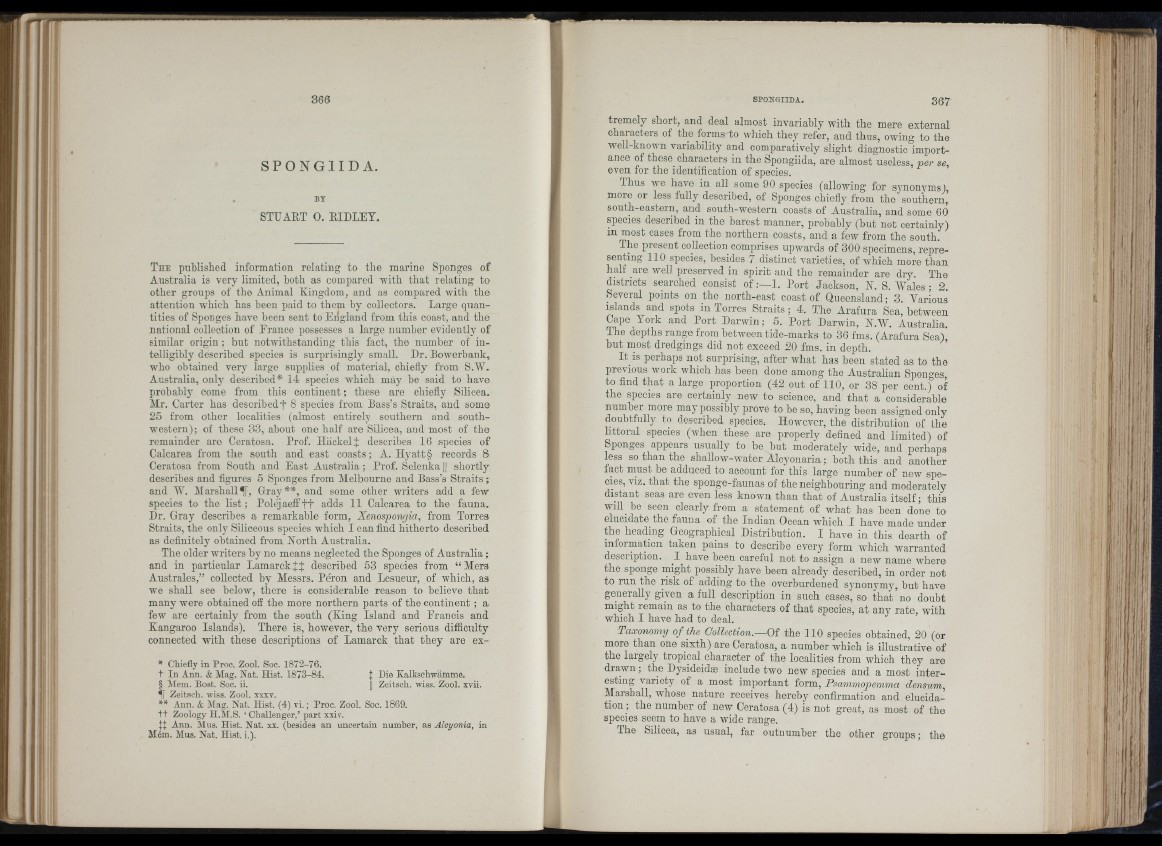
il
íil I
»•i
S PO N G I ID A .
BY
STUART 0 . RIDLEY.
The published information relating to the marine Sponges of
Australia is very limited, both as compared with th at relating to
other groups of the Animal Kingdom, and as compared with the
attention which has been paid to them by collectors. Large quantities
of Sponges have been sent to England from this coast, and the
national collection of Erance possesses a large number evidently of
similar origin ; but notwithstanding this fact, the number of intelligibly
described species is surprisingly small. Dr. Bowerhank,
who ohtained very large supplies of material, chiefly from S.W.
Australia, only described* 14 species which may he said to have
probably come from this continent; these are chiefly Silicea.
Air. Carter has described f 8 species from Bass’s Straits, and some
25 from other localities (almost entirely southern and southwestern);
of these 33, about one half are Silicea, and most of the
remainder are Ceratosa. Prof. HackelJ describes 16 species of
Calcarea from the south and east coasts; A. Hyatt§ records 8
Ceratosa from South and East Australia; Prof. Selenka |l shortly
describes and figures 5 Sponges from Alelbourne and Bass’s S tra its ;
and AV. Alarshall^, Gray**, and some other writers add a few
species to the lis t; P o le ja e fftt adds 11 Calcarea to the fauna.
Dr. Gray describes a remarkable form, Xenospongia, from Torres
Straits, the only Siliceous species which I can find hitherto described
as definitely obtained from North Australia.
The older writers by no means neglected the Sponges of Australia;
and in particular Lamarck]:]; described 53 species from “ Alers
Australes,” collected by Messrs. Peron and Lesueur, of which, as
we shall see below, there is considerable reason to believe th at
many were obtained off the more northern parts of the continent; a
few are certainly from the south (King Island and Francis and
Kangaroo Islands). There is, however, the very serious difficulty
connected with these descriptions of Lamarck th at they are exJ
* Chiefly in Proc. Zool. Soc. 1872-76.
t In Ann. & Mag. Nat. Hist. 1873-84.
Die Kalkschwamme.
§ Mem. Boat. Soc. ii.
II Zeitsch. wiss. Zool. xvii.
^ Zeitsch. wiss. Zool. xxxv.
** Ann. & Mag. Nat. Hist. (4) vi.; Proc. Zool. Soc. 1869.
t t Zoology H.Al.S. ‘ Challenger,’ part xxiv.
]] Ann. Mus. Hist. Nat. xx. (besides an uncertain number, as Alcyonia, in
Mém. Alus. Nat. Hist. i.).
tremely short, and deal almost invariably with the mere external
characters of the forms to which they refer, and thus, owing to the
well-known variability and comparatively slight diagnostic importance
of these characters in the Spongiida, are almost useless, per se,
even for the identification of species.
Thus we have in all some 90 species (allowing for synonyms)
more or less fully described, of Sponges chiefly from the southern,’
south-eastern, and south-western coasts of Australia, and some 60
species described iu the barest manner, probably (but not certainly)
in most cases from the northern coasts, and a few from the south.
The present collection comprises upwards of 300 specimens, representing
110 species, besides 7 distinct varieties, of which more than
half are well preserved in spirit and the remainder are dry The
districts searched consist o f:—1. Port Jackson, N. S. AAAles ; 2.
Several points on tho north-east coast of Queensland; 3. Various
islands^and spots in Torres Straits; 4. The Arafura Sea, between
Cape York and Port Darwin; 5. Port Darwin, N.W. Australia.
The depths range from between tide-marks to 36 fms. (Arafura Sea)'
but most dredgings did not exceed 20 fms. in depth.
I t is perhaps not surprising, after what has been stated as to the
previous work which has been done among the Australian Sponges,
to find th a t a large proportion (42 out of 110, or 38 per cent.) of
the species are certainly new to science, and th at a considerable
number more may possibly prove to he so, having been assigned only
doubtfully to described species. However, the distribution of the
littoral species (when these are properly defined and limited) of
Sponges appears usually to be but moderately wide, and perhaps
less so than the shallow-water Alcyonaria; both this and another
fact must be adduced to account for this large number of new species,
viz. th a t the sponge-faunas of the neighbouring and moderately
distant seas are even less known than th at of Australia itself; this
will be seen clearly from a statement of what has been done to
elucidate the fauna of the Indian Ocean which I have made under
the heading Geographical Distribution. I have in this dearth of
information taken pains to describe every form which warranted
description. I have been careful not to assign a new name where
the sponge might possibly have been already described, in order not
to run the risk of adding to the overburdened synonymy, hut have
generally given a full description in such cases, so th at no doubt
might remain as to the characters of th at species, a t any rate, with
which I have had to deal.
Taxonomy o f the Collection.~0t the 110 species obtained, 20 (or
more than one sixth) are Ceratosa, a number which is illustrative of
the largely tropical character of the localities from which they are
d raw n ; the Dysideidai include two new species and a most in te resting
variety of a most important form, Psammopemma densum,
Alarsball, whose nature receives hereby confirmation and elucidation
; the number of new Ceratosa (4) is not great, as most of the
species seem to have a wide range.
The Silicea, as usual, far outnumber the other groups; the
i. 'il